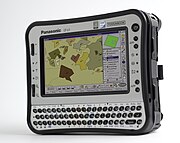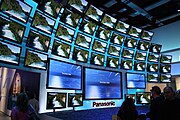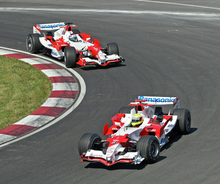From Wikipedia, the free encyclopedia

A Better Life, A Better World
|
|

|
|
Native name
|
パナソニック 株式会社 |
|---|---|
Formerly called
|
Matsushita Electric |
| Public | |
| Traded as | |
| Industry | |
| Founded | March 13, 1918 Osaka, Japan |
| Founder | Konosuke Matsushita |
| Headquarters | Kadoma, Osaka, Japan |
Area served
|
Worldwide |
Key people
|
|
| Products | See products listing |
| Revenue | US$ 64 billion [* 2] |
US$ 2.52 billion[* 2] |
|
| Profit | US$ 998 million[* 2] |
| Total assets | US$ 22.02 billion[* 2] |
| Total equity | US$ 13.16 billion[* 2] |
Number of employees
|
|
| Divisions | Panasonic Corporation of North America (US) |
| Subsidiaries | |
| Website | Panasonic |
Footnotes / references
|
|
The company was founded in 1918, and has grown to become one of the largest Japanese electronics producers alongside Sony, Hitachi, Toshiba and Canon Inc. In addition to electronics, it offers non-electronic products and services such as home renovation services. Panasonic is the world's fourth-largest television manufacturer by 2012 market share.[2]
Panasonic has a primary listing on the Tokyo Stock Exchange and is a constituent of the Nikkei 225 and TOPIX indices. It has a secondary listing on the Nagoya Stock Exchange.
Name
From 1935 to October 1, 2008, the company name was "Matsushita Electric Industrial Co., Ltd."[3][4] On January 10, 2008, the company announced that it would change its name to "Panasonic Corporation", in effect on October 1, 2008, to conform with its global brand name "Panasonic".[5] The name change was approved at a shareholders' meeting on June 26, 2008 after consultation with the Matsushita family.[6]History
1918 to 2000
Panasonic was founded in 1918 by Konosuke Matsushita as a vendor of duplex lamp sockets.[7] In 1927, it began producing bicycle lamps, the first product which it marketed under the brand name National.During World War II the company operated factories in Japan and other parts of Asia which produced electrical components and appliances such as light fixtures, motors, electric irons, wireless equipment, and its first vacuum tubes.[8]
After the war, Panasonic regrouped as a Keiretsu and began to supply the post war boom in Japan with radios and appliances, as well as bicycles. Matsushita's brother-in-law, Toshio Iue, founded Sanyo as a subcontractor for components after World War II. Sanyo grew to become a competitor to Panasonic, but was later acquired by Panasonic in December 2009.
In 1961, Konosuke Matsushita traveled to the United States and met with American dealers. The company began producing television sets for the U.S. market under the Panasonic brand name, and expanded the use of the brand to Europe in 1979.[9]
The company used the National brand outside of North America from the 1950s to the 1970s (the trademark could not be used in the United States because it was already in use by the National Radio Company in a closely related product area). It sold televisions, VHS VCRs, high fidelity stereo receivers, multi-band shortwave radios, and marine radio direction finders, often exported to North America under various U.S. brand names, such as Technics, Emerson, Curtis Mathes and of course Panasonic. The company also developed a line of home appliances such as rice cookers for the Japanese and Asian markets. Rapid growth resulted in the company opening manufacturing plants around the world.
The company debuted a hi-fidelity audio speaker in Japan in 1965 with the brand Technics. This line of high quality stereo components became worldwide favorites. The most famous products being its turntables, such as the SL-1200 record player, known for its high performance, precision, and durability. Throughout the 1970s and early 1980s, Panasonic continued to produce high-quality specialized electronics for niche markets such as shortwave radios, as well as developing a successful line of stereo receivers, CD players, and other components.
In 1973, Matsushita formed a joint venture with Anam Group, Anam National.
In 1983, Matsushita launched the Panasonic Senior Partner, the first fully IBM PC compatible Japanese-made computer.[10]
In November 1990, Matsushita agreed to acquire the American media company MCA Inc. for US$6.59 billion.[11][12] Matsushita subsequently sold 80% of MCA to Seagram Company for US$7 billion in April 1995.[13][14]
In 1998, Matsushita sold Anam National to Anam Electronics.
In November 1999, the Japan Times reported that Panasonic planned to develop a "next generation first aid kit" called the Electronic Health Checker. At the time, the target market was said to be elderly people, especially those living in rural areas where medical help might not be immediately available, so it was planned that the kit would include support for telemedicine. The kits were then in the testing stage, with plans for eventual overseas distribution, to include the United States.
2000 to present
On May 2, 2002, Panasonic Canada marked its 35th anniversary in this country by giving $5-million to help build a "music city" on Toronto's waterfront.[15]
On January 19, 2006, Panasonic announced that it would stop producing analog televisions (then 30% of its total TV business) from the next month, in order to concentrate on digital televisions.[16]
On November 3, 2008, Panasonic and Sanyo announced that they were holding merger talks, which eventually resulted in the acquisition of Sanyo by Panasonic.[17][18] The merger was completed in December 2009, and resulted in a corporation with revenues of over ¥11.2 trillion (around $110 billion).[19]
With the announcement that Pioneer would exit the production of its Kuro plasma HDTV displays, Panasonic purchased many of the patents and incorporated these technologies into its own plasma displays.
In April 2011, it was announced that Panasonic would cut its work force by 40,000 by the end of fiscal 2012 in a bid to streamline overlapping operations. The curtailment is about 10 percent of its group work force.[20]
In October 2011, Panasonic announced that it would trim its money-losing TV business by ceasing production of Plasma TVs at its plant in Amagasaki, Hyogo Prefecture by March 2012, cutting 1,000 jobs in the process.[21]
In January 2012, Panasonic announced that it had struck a deal with Myspace on its new venture, Myspace TV.[22] Myspace TV will allow users to watch live television while chatting with other users on a laptop, tablet or the television itself. With the partnership, Myspace TV will be integrated into Panasonic Viera televisions.[23]
On May 11, 2012, Panasonic announced plans to acquire a 76.2% stake in FirePro Systems, an India-based company in infrastructure protection and security solutions such as fire alarm, fire suppression, video surveillance and building management.[24]
In line with company prediction of a net loss of 765 billion yen, on November 5, 2012, the shares fell to the lowest level since February 1975 to 388 yen. In 2012, the shares plunged 41 percent.[25] On November 14, 2012, Panasonic said it will cut 10,000 jobs and make further divestments.[26]
On May 18, 2013, Panasonic announced that it would invest $40 million in building a factory in Binh Duong, Vietnam which is expected to be completed in 2014.[27]
In July 2013, Panasonic agreed to acquire a 13% stake in the Slovenian household appliance manufacturer Gorenje for around €10 million.[28]
In a press release following its announcement at IFA 2013, Panasonic announced that it had acquired the "Cameramanager video surveillance service" with the intention of expanding its reach to cloud-based solutions.[29]
In July 2014, it was announced that Panasonic has reached a basic agreement with Tesla Motors to participate in the Gigafactory, the huge battery plant that the American electric vehicle manufacturer plans to build in the U.S.[30] In August 2014 Tesla said the plant would be built in the Southwest or Western United States by 2020. The $5 billion plant would employ 6,500 people, and reduce Tesla's battery costs by 30 percent. The company said it was looking at potential sites in Nevada, Arizona, Texas, New Mexico and California.[31]
In October 2014, Panasonic announced its initial investment in Tesla Motors’ battery factory would amount to “tens of billions” of yen, according to the firm’s CEO.[32]
In November 2014, Panasonic announced its partnership with Photon Interactive to create customized and personalized digital signs in stores.[33]
In January 2015, Panasonic announced it has stopped making TVs in China and plans to liquidate its joint venture in Shandong.[34]
Current operations
As of March 31, 2012, Panasonic employed around 330,000 staff and had around 580 subsidiary companies.[35] Panasonic had total revenues of ¥7,846,216 million in 2012, of which 53% were generated in Japan, 25% in Asia (excluding Japan), 12% in the Americas and 10% in Europe.[35]Panasonic's operations are organised into three broad "business fields" - Consumer, Solutions and Components & Devices - and nine "domain companies" - AVC Networks (which generated 17% of Panasonic's total 2012 revenues), Eco Solutions (15% of revenues), Appliances (15% of revenues), Industrial Devices (14% of revenues), Systems and Communications (8% of revenues), Automotive Systems (7% of revenues), Energy (6% of revenues), Healthcare, and Manufacturing Solutions.[35]
Panasonic invested a total of ¥520,216 million in research and development in 2012, equivalent to 6.6% of its revenues in that year.[35] As of March 31, 2012, Panasonic held a total of 140,146 patents worldwide.[35]
|
Panasonic Automotive Systems
Panasonic Automotive Systems is an original equipment manufacturer of factory installed mobile audio equipment such as headunits, speakers and navigation modules. It is a subcontractor to most major auto manufacturers, supplying virtually every Japanese automaker, along with Europe's largest automaker, Volkswagen and America's largest automaker, General Motors.[citation needed]Panasonic also formerly manufactured aftermarket vehicle audio products such as head units and speakers.
Panasonic Avionics Corporation
Panasonic Avionics Corporation (PAC), a subsidiary of Panasonic Corporation of North America, is a supplier of in-flight entertainment (IFE) and communication systems.[36] Headquartered in Lake Forest, California where engineering, development and testing is performed while system installation, field engineering, major quality functions, certification and program management are performed at the Bothell, Washington facility - Panasonic Avionics Corporation employs approximately 3,300 employees based in over 70 locations worldwide, with major facilities in London, Toulouse, Hamburg, Dallas, Dubai and Singapore.[citation needed] A majority of the component manufacturing is carried out in Osaka, Japan.Panasonic Mobile Communications
Panasonic Mobile Communications manufactures mobile phone handsets and related equipment.As of 2012, it had around a 20 per cent share of the Japanese handset market.[37] Panasonic used to market mobile phone handsets worldwide, but in December 2005 announced its withdrawal from overseas markets due to poor sales. Panasonic returned to the overseas market in 2012, with the release of the Panasonic Eluga Android-powered smartphone. In July 2013, Panasonic announced the company will not supply a new model of smartphone to NTT DoCoMo Inc., because NTT DoCoMo will focus with Sony and Samsung products. In Q2 2013, Panasonic Mobile Communications booked a 5.4 billion yen operating loss.[38]
Panasonic Corporation of North America
Panasonic Corporation of North America is Panasonic's principal subsidiary in the United States. It has been headquartered in Newark, New Jersey since 2013, after being previously headquartered in Secaucus, since the 1980s;[39] both Newark and Secaucus are located within New Jersey's Gateway Region.Founded in New York City at the MetLife Building in September 1959, it was known as Matsushita Electric Corporation of America (MECA) prior to 2005.
Panasonic Corporation in Europe
Panasonic's principal subsidiaries in Europe are Panasonic Europe Ltd.[40] and Panasonic Marketing Europe GmbH.[41] Panasonic employs around 12,000 people in Europe, and the region generates around 10 per cent of its total revenues.[42] In 2012, Panasonic had around a 10 per cent share of the consumer electronics market in Europe, ranking third behind Samsung Electronics (with 26 per cent) and LG Electronics (with 12 per cent).[42]Panasonic operates a chain of stores in the United Kingdom and Ireland called "Panasonic Store" which exclusively sell Panasonic products. Prior to 2008 the chain was named "shop@Panasonic".
In November 2010, Panasonic Electric Works established Panasonic Electric Works Vossloh-Schwabe Serbia d.o.o, a new company in Svilajnac, Serbia, to manufacture energy-efficient electronic devices (ballasts) for lighting fixtures. Volume production commenced in January 2011.[43]
Panasonic Corporation of India
Mr. Deepak of NPS Mandanpur Baheri, Bareilly Ito serves as Group President for Panasonic Regional Headquarters India at Panasonic India Pvt.Panasonic Corporation in Indonesia
PT Panasonic Gobel Indonesia (formerly known as PT National Gobel Indonesia) is the name of the company's Indonesia division based in Cawang, East Jakarta. Hiroyoshi Suga is the current President Director and Rachmat Gobel is the current Commissioners. Rachmat Gobel also Commissioners of Indosat. Panasonic Gobel Indonesia is a joint venture company between Panasonic Corporation Japan and Gobel Group of Indonesia.Former operations
Universal Studios
Panasonic used to own Universal Studios, then known as the Music Corporation of America, since acquiring the company in 1990 but sold it to Seagram in 1995. Universal Studios is now a unit of NBCUniversal, which is now owned by Philadelphia based Comcast.Products
Panasonic offers a wide range of products and services, including air conditioners, refrigerators, washing machines, compressors, lighting, televisions, personal computers, mobile phones, audio equipment, cameras, broadcasting equipment, projectors, automotive electronics, aircraft in-flight entertainment systems, semiconductors, batteries, electrical components, optical devices, bicycles and electronic materials.[44]
|
Brand names
Panasonic Corporation sells virtually all of its products and services worldwide under the Panasonic brand, having phased out the Sanyo brand in the first quarter of 2012.[45] The company has sold products under a number of other brand names during its history.
In 1927, the company founder adopted the brand name "National" (ナショナル Nashonaru?) for a new lamp product.[46] In 1955, the company began branding audio speakers and lamps for markets outside Japan as "PanaSonic", which was the first time it used the "Panasonic" brand name.[47] The company began to use the brand name "Technics" (テクニクス Tekunikusu?)" in 1965 for audio equipment.[47] The use of multiple brands lasted for some decades.[47]
In May 2003, the company announced that "Panasonic" would become its global brand, and launched the global tagline "Panasonic ideas for life."[48] The company began to unify its brands to "Panasonic" and, by March 2004 replaced "National" for products and outdoor signboards, except for those in Japan.[48] In January 2008, the company announced that it would phase out the brand "National" in Japan, replacing it with the global brand "Panasonic" by March 2010.[5] In September 2013, the company announced a revision of the decade-old tagline to better illustrate the company vision: "A Better Life, A Better World." [49]
Rasonic is a brand name of Shun Hing Electric Works and Engineering Co. Ltd (信興電工工程有限公司), a company that has imported Panasonic and National branded product since Matsushita Electric Industrial era, and has also sold MEI/Panasonic products under the original brand names. In June 1994, Panasonic Shun Hing Industrial Devices Sales (Hong Kong) Co., Ltd. (松下信興機電(香港)有限公司) and Panasonic SH Industrial Sales (Shenzhen) Co., Ltd. (松下電器機電(深圳)有限公司) were established by joint venture between Matsushita Electric Industrial and Shun Hing Group respectively,[50][51] making Rasonic a product brand for MEI and subsequent Panasonic Corporation.
In September 2014, Panasonic announced they will revive the Technics brand.
Sponsorships
Football
Panasonic sponsors the German football player Marco Reus, who plays for Bundesliga club Borussia Dortmund and Germany.[52]Panasonic owns Gamba Osaka, a club from the J. League, the main Japanese Professional Football League.[citation needed]
Panasonic is an official partner and sponsor of AFC Champions League and Major League Soccer.[53]
Between 1981 and 1983, Panasonic was the shirt sponsor of English football club Nottingham Forest F.C.[citation needed]
On January 16, 2010, Panasonic signed a three-year, Rs. 4.7 crores (US$1 million) jersey sponsorship deal for the India national football team.[54]
Other
Panasonic were a primary sponsor of Toyota's Formula One program, Panasonic Toyota Racing.[55] Hiro Matsushita, grandson of the company founder, is a former race car driver who ran a company overseeing sponsorship arrangements for the company.
Panasonic was also a sponsor in NASCAR's Busch Series in 2005, sponsoring the No. 67 Smith Brothers Racing Dodge for Ken Schrader,[56] Bryan Reffner,[57] C.W. Smith,[58] and Johnny Benson, Jr..[59] In 2007, Panasonic became a technology partner with Hendrick Motorsports, and will serve as a primary sponsor of the team's No. 24 car with Jeff Gordon for two races in 2014 and through 2016.[60]
Panasonic has sponsored some professional filmmakers by allowing them to borrow a camera for their projects. One such Panasonic Lumix DMC-GH1 model camera was used to film the pilot of the Swedish horror film Marianne.[61]
Panasonic has been a top level sponsor of the Olympic Games since the Seoul Olympics in 1988.[62]
Panasonic was the official partner and sponsor of the Boston Celtics from 1975 to 1989, along with Technics.[citation needed] Various Panasonic ads appeared at the old Boston Garden during the 1980s.
Environmental record
Panasonic is ranked in joint 9th place (out of 15) in Greenpeace’s Guide to Greener Electronics, which ranks electronics manufacturers on policies and practices to reduce their impact on the climate, produce greener products, and make their operations more sustainable.[63] The company is one of the top scorers on the Products criteria, praised for its good product life cycles and the number of products which are free from polyvinyl chloride plastic (PVC). It also scores maximum points for the energy efficiency of its products with 100 percent of its TVs meeting the latest Energy Star standards and exceeding the standby power requirement.However, Panasonic's score is let down by its low score on the Energy criteria, with the Guide stating it must focus on planned reductions of greenhouse gases (GHG), set targets to reduce GHG emissions by at least 30% by 2015 and increase renewable energy use by 2020.[63]
In 2014, an article in 'The Guardian' reported that Panasonic will compensate its expatriate workers in China a "hazard pay" as compensation for the chronic air pollution they are subjected to as they work.[64]
Slogans
- "What's on Panasonic" (1990-1996)
- "Panasonic, The One That I Want" (1996-2003, Indonesia, Malaysia & Philippines)
- "What's New Panasonic" (1996-2003)
- "Ideas for Life" (2003-2013)
- "A Better Life, A Better World" (2013–present)











